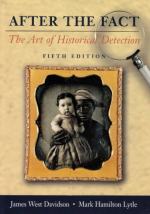|
This section contains 915 words (approx. 3 pages at 400 words per page) |

|
The Reliability of Historical Evidence
Throughout the book, the authors are continually demonstrating how the historian must assess the reliability of the available evidence. Documentary evidence, paintings, photographs and other types of evidence are all produced from the point of view of their creators. This point of view must be accounted for when looking for a "true" account of historical events as they actually happened.
As one example, the authors present a passage written by Captain John Smith, who led the Virginia Colony in the 17th century. Smith witnessed a Native American ritual of some kind and described it in writing. As the authors demonstrate, however, Smith's account was given in terms that were familiar to him and would have been familiar to his readers. He did not know the intended meaning of the ritual or the traditional roles of the people involved. He simply described the events as...
|
This section contains 915 words (approx. 3 pages at 400 words per page) |

|




